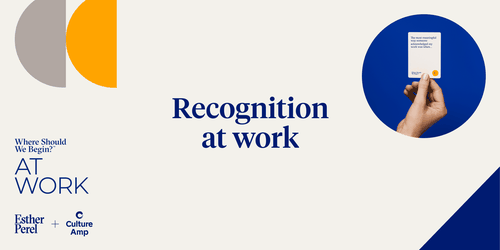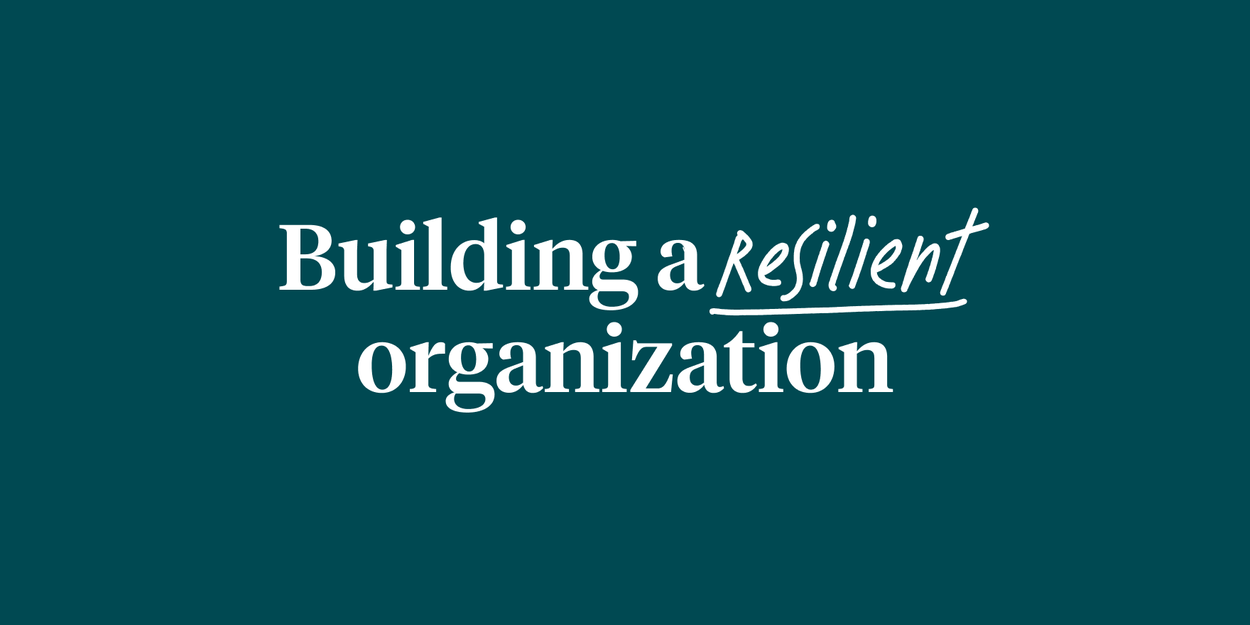
HR leaders are struggling to make plans for the future. With so many unknowns, it can be challenging to prepare for specific scenarios. That’s why we’re encouraging HR teams to use this time to build responsive organizations instead of trying to predict the future. To support companies with this goal, we partnered with RedThread Research to create a framework that will help you think about how to go about building a resilient organization.
The key to responsive organizations: Managers
What are the characteristics of a resilient organization? Put simply, a resilient or responsive organization is one that adapts quickly and efficiently in the face of new information, problems, or circumstances. It’s essential to distinguish responsiveness from reactiveness. Responsive organizations don’t just react to changing circumstances – they also proactively prevent issues down the road.
Investing in building a responsive organization is well worth the effort. Culture Amp's research found that responsive organizations perform better – regardless of external circumstances. Before COVID-19 even started, we found that 95% of responsive organizations met or exceeded their business goals in each of the previous three years, compared to just 21% of the least responsive organizations. We saw similarly strong performance when responding to market changes, innovating, satisfying customers, and engaging employees.
Another key finding from our research is that when managers engage in certain behaviors, they are more responsive to disruptions and can turn them into competitive advantages. That’s why the first step to building a responsive organization is for HR leaders to focus on enabling managers to be as adaptable as possible in the face of a very uncertain future. Now, with the possibility of a recession on our horizon, prioritizing building resilience in the workplace is more important than ever.
4 characteristics of resilient organizations
What are the behaviors HR should be encouraging in their managers? Our research revealed four lenses of high responsivity. It also showed that a highly effective manager contains attributes across all four lenses.
1. Respect
Respect is foundational to responsiveness. This means that all employees should feel respected for their abilities, knowledge, skills, and ideas. While the organization can and should extend respect to employees, it’s the manager who truly shows up as the primary enabler of respect.
How HR can enable managers:
- Encourage employees to provide perspectives. Managers must provide ways for employees to share their views on various aspects of their experience. This can happen during 1-on-1 meetings or more casual check-ins with team members. You should coach managers on how to have open-ended conversations with employees and collect their thoughts on topics like engagement, leadership effectiveness, and working remotely – among others.
- Encourage employees to provide ideas through technology. It can quickly become overwhelming for managers to manually collect all this feedback from employees. Overlooked feedback increases the likelihood that their ideas won’t be acted on – which doesn’t exactly build respect. That’s where leveraging technology can be helpful. Pairing an effective employee feedback strategy with a platform like Culture Amp can make the task of collecting, condensing, and acting on employee suggestions much easier.
- Provide a psychologically safe work environment. To feel respected, employees need to feel heard. Respect goes beyond just listening to their concerns at work. Companies also need to create a venue where employees feel safe discussing the personal challenges they’re dealing with in 2023 and beyond – whether that’s struggling with their mental health, fears about the economic climate, or feeling overwhelmed by the social injustices happening around the world.
2. Distributed authority
Responsive organizations distribute authority throughout the company and empower all levels of the organization to act. To do this, organizations must rely on guiding principles, quality data, and insights, and employees’ understanding and capabilities to speed up decision-making and action – and managers are the keys to unlocking this.
How HR can enable managers:
- Focus on value-adding tasks. To empower employees to act, managers have to clarify what to do and where to focus their resources. For example, this could be as simple as letting employees know that internal PowerPoint presentations don’t need to look beautiful. This relieves team members from worrying about aesthetics – which doesn’t necessarily add value – and empowers them to focus solely on the content instead.
- Enhance understanding of team engagement. HR leaders can empower managers to take action with their teams by providing them with relevant data from pulse and engagement surveys. This can include anything from people-focused data to diversity, equity, and inclusion (DEI) data.
- Clarify understanding of the decision-making authority. Once data has been shared with managers, HR should also clarify how to take appropriate actions. Without direction, the decision-making process can become muddled. To avoid this, you can introduce tools like a “decision log” to keep track of important decisions. Similarly, companies can also create frameworks that help managers and employees consistently make better decisions.
3. Growth & transparency
Employees are looking for more clarity than ever before and will likely continue to do so. Our data shows how critical this type of transparency is to provide – especially now. Managers need to focus on delivering their direct reports with transparency in three areas:
- Past performance
- Future expectations
- Growth
How HR can enable managers:
- Increase feedback opportunities. One of the best ways to encourage transparency is to provide more opportunities for feedback. Technology can make this process more seamless by providing data to employees about their performance. For example, using tools that share feedback on the tone of employees during phone calls and emails. Enabling a culture that encourages continuous feedback from managers and peers is also critical to this process.
- Manage expectations. You should also encourage managers to have thoughtful conversations with their employees about reprioritizing goals. Encourage employees to rethink their work in the context of the current economic and social climate. Reviewing these goals frequently during check-ins and having them be more focused on the short term can make the process easier for everyone involved.
- Support manager growth. Our research found that skills like agility, resiliency, empathy, and vulnerability are becoming more critical as managers navigate this year’s challenges. That’s why we encourage HR teams to invest in upskilling their managers in these areas to better support their employees’ needs. Manager training can take many forms, such as workshops, leadership development programs, and on-demand learning platforms.
4. Trust
Organizations with trust don’t just respect and listen to employees – they adopt a community mindset. These organizations have ceased to think in terms of “us” (managers) and “them” (employees) and instead have adopted a “we’re all in this together” attitude. That attitude helps employees learn from their mistakes and invest in solving problems together.
How HR can enable managers:
- Value employees. One of the most effective methods we’ve heard of over the years for valuing employees – and one that HR can enable – is implementing employee recognition programs. This can be done through a formalized practice or can be more informal, such as a shoutout from a peer on Slack or a private “thank you” note from a company leader. It’s up to the manager’s discretion to recognize their employees in ways that are personally meaningful to them.
- Foster openness. To create a culture of trust, there needs to be a sense of transparency between managers and their employees. But that’s not the only meaningful relationship. The senior leaders at an organization also need to demonstrate, by example, how to foster a culture of openness and set a good example for managers. HR teams can facilitate this by hosting “Ask Me Anything” (AMA) events with the C-suite, having executives regularly communicate updates through email, or encouraging leaders to have regular coffee dates with the rest of the organization.
- Connect to the community. The same concept applies to creating a community. Company leaders need to model connective behaviors at the top. One way we’ve seen senior leaders do this recently is by making significant efforts to support social justice issues and engaging more fully in a discussion about what it means to be Black in corporate life. HR teams can support managers in these conversations with employees by offering resources – whether that’s creating new learning paths or providing guides on how to approach challenging topics.
To survive and thrive in the upcoming months, we must shift our priorities from figuring out the unknown to practicing responsive behaviors. Start with your managers to impact the organization on a broader level using our recommendations.





